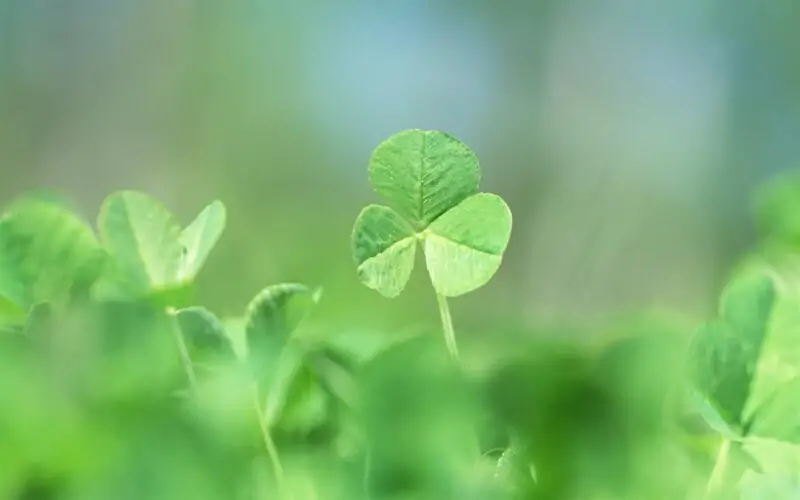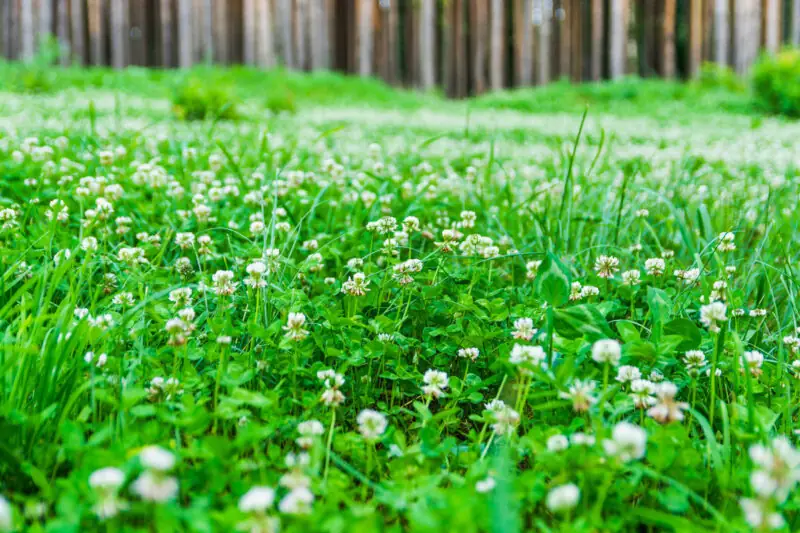Cultivating a Thriving Clover Lawn: Your Comprehensive Guide to White Clover Plant (Trifolium Repens)

Today let’s turn our attention to an unassuming hero of the plant kingdom, the clover plant. As we delve into this topic, you’ll learn about the clover’s significance, its life cycle, benefits to our lawns, and how it contributes to pollinator health. It’s far more than just a lucky charm!
The Significance of Clover
Let’s start with this – clover is more than just a plant. Belonging to the Trifolium genus, it’s actually a legume, a proud member of the Fabaceae family, which includes peas and beans. This characteristic allows clover, through its root system, to perform a natural miracle – it can fix nitrogen right from the air, turning it into a usable form, directly in the soil.
Imagine Clover as a small, green nitrogen factory in your backyard. This impressive feature allows it to enrich your lawn, adding valuable nutrients that other plants crave. It’s a natural fertilizer, filling up poor soil areas with essential elements. Pretty cool, right?
Different Types of Clover: Spotlight on White Clover
There are many species of clover, each with their unique traits. But, for our discussion, let’s zero in on white clover, known to the science folks as Trifolium repens. It’s the species you’re most likely to encounter, whether on a walk through a meadow or right on your own lawn.
Originating from Europe, white clover has made itself at home in many parts of the world. It’s the kind of guest that fits right in, becoming naturalized in new places while causing little fuss. It doesn’t grow very tall, but it’s a ground cover champ, spreading up to 12 inches wide.
Not to mention, it’s quite the looker. It flaunts trifoliate leaves – yeah, those famous three leaflets we all associate with luck – and small white flower heads. These flowers often carry a hint of pink, adding a dash of color to the otherwise lush green plant.
The Biology of Clover
Understanding Clover’s Life Cycle
Each clover plant starts life as tiny clover seeds. They’re typically sown on the surface of the soil, as sunlight aids their germination. Once the last frost has bid adieu, the seeds start sprouting. The plant grows steadily throughout the warm months, all the way until the first frost signals the end of the growing season. During its growth, the clover plant doesn’t just sit pretty. It’s constantly working, taking in nitrogen from the atmosphere, and turning it into a form usable by different plants. It’s this process that enriches the soil, making your lawn or garden healthier and more fertile.
The Role of Clover in Ecosystems
Clover isn’t just beneficial for your lawn. It plays a significant role in larger ecosystems as well. As a ground cover, it protects the soil surface, preventing erosion. It also competes with less desirable plants, helping keep your garden weed-free.
Beyond this, clover serves as a valuable food source for many critters. Its leaves provide forage for various animals, while its nectar-filled flowers are a sweet treat for pollinators like honeybees. This dual role makes Clover an ecosystem superstar, nourishing both the soil and its inhabitants.
Clover and Lawns

Benefits of a Clover Lawn
Adding clover to your lawn comes with a host of benefits. It’s an excellent way to fertilize your lawn naturally, without needing to buy, store, or apply commercial fertilizers. And as it tolerates dry soils and repeated mowing, it’s pretty low-maintenance.
Having clover in your lawn also means fewer pests. Clover competes with common weeds, helping to keep your lawn weed-free. What’s more, it’s naturally resistant to many pests that bother other grasses, making it a great addition to your existing lawn.
How Clover Enhances Lawn Health
Aside from its pest-resistance, Clover brings several other benefits to your lawn. It’s a perennial, which means it comes back year after year, filling in bare patches and keeping your lawn looking lush.
Additionally, clover spreads, growing horizontally across the lawn. This helps to cover up any bare patches that might develop. It’s also tolerant of a range of soil conditions, performing best in loam but also able to cope with less fertile or dry soils.
Potential Issues with Clover in Lawns
Of course, not everything about Clover is perfect. Some folks might consider it a pest. After all, in a traditional lawn, it might stand out a bit. But consider this: a lawn with clover is also a lawn that’s more resistant to drought, requires less mowing, and attracts beneficial insects like bees.
Planting and Cultivating Clover
How to Plant Clover Seeds
Thinking about growing clover? Great! Let’s talk about how to get started. First, you’ll need some clover seeds. These can be sown in your existing lawn or a new area. If you’re using them in your existing lawn, first rake the area to loosen up the soil and give the seeds a good start.
When it comes to sowing clover, there’s no need to bury the seeds. They’re best sown on the soil surface. You can mix the seed with sand to help distribute it evenly. Once you’ve sown the seeds, give the area a good watering, and before you know it, you’ll have clover growing!
Factors Affecting Clover Growth
Like any plant, clover has its preferences. While it’s tolerant of a variety of conditions, it performs best in partial sun and moist soil. That said, it’s a tough little plant. It’s drought-resistant and even able to cope with poor soil.
Maintenance of Clover Lawns
One of the best things about a clover lawn is how low-maintenance it is. It tolerates mowing and can even handle high traffic very well. It’s a robust plant, able to bounce back from being trampled.
In terms of feeding, clover does not require fertilizer. It makes its own nitrogen, remember? And while it’s resistant to many pests, it may occasionally attract rabbits or other wildlife.
Clover as a Pollinator Attractor
How Clover Attracts Pollinators
A blooming clover lawn is like a dinner bell for pollinators. Bees, butterflies, and other beneficial insects can’t resist the sweet nectar of clover flowers. Having clover in your landscape attracts these helpful creatures, helping to pollinate your vegetable garden and other plants.
Importance of Clover for Pollinator Health
But it’s not just about our gardens. Pollinators need all the help they can get. Planting clover, especially varieties like white clover or Dutch clover, provides a valuable food source for them. It’s especially important for honeybees, as clover honey is one of the most popular types.
Enhancing Your Garden to Attract More Pollinators
Want to attract even more pollinators? Consider adding more flowering plants to your garden. Varieties such as the pink-flowering Swedish clover or the spherical Alsike can add visual interest and provide additional nectar sources. Just remember, the more diversity, the better!
Clover and Pests
Common Pests for Clover
While clover is fairly resistant to pests, there are a few that it may attract. Common pests include aphids, slugs, and some types of beetles. However, don’t be too quick to grab the herbicide. Many of these can be controlled with simple, organic methods.
Strategies for Managing Clover Pests
First off, remember that a healthy plant is more resistant to pests. Keeping your clover well-watered and mowed can go a long way toward preventing issues. If pests do appear, try natural controls first. For instance, a strong spray of water can knock aphids right off the plant.
Organic Pest Control Methods for Clover
For more persistent pests, consider introducing beneficial insects. Ladybugs and lacewings, for instance, are natural predators of aphids. And while slugs might be trickier to deal with, a shallow dish of beer can lure them away from your plants.
FAQs
Absolutely! Clover adds valuable nitrogen to the soil, helping to improve the health of your lawn. It also competes with weeds and is resistant to many common lawn pests.
Clover seeds can be sprinkled right on the soil surface. Consider mixing them with sand for even distribution. Water them in well, and you’ll have clover sprouting in no time.
Clover attracts a wide range of pollinators, including bees, butterflies, and other beneficial insects. It’s an excellent addition to a pollinator-friendly garden.
Healthy clover is naturally resistant to many pests. If you do notice a problem, try organic control methods first. These could include a strong spray of water for aphids or introducing beneficial insects for more persistent pests.
Conclusion
So, that’s the low-down on the clover plant. As we’ve seen, this humble legume is a real powerhouse. From enriching our soils and lawns to supporting valuable pollinators, clover does it all. Whether you’re a seasoned gardener or just getting started, consider giving clover a spot in your landscape.